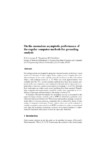On the anomalous asymptotic performance of the regular computer methods for grounding analysis

Ver/
Use este enlace para citar
http://hdl.handle.net/2183/400Coleccións
- Investigación (ETSECCP) [826]
Metadatos
Mostrar o rexistro completo do ítemTítulo
On the anomalous asymptotic performance of the regular computer methods for grounding analysisData
2003Resumo
[Abstract] Grounding systems are designed to guarantee personal security, protection of equipments
and continuity of power supply. Hence, engineers must compute the equivalent
resistance of the system and the potential distribution on the earth surface
when a fault condition occurs [1, 2, 3]. While very crude approximations were
available until the 70’s, several computer methods have been more recently proposed
on the basis of practice, semi-empirical works and intuitive ideas such as superposition
of punctual current sources and error averaging [1, 3, 4, 5, 6]. Although
these techniques are widely used, several problems have been reported. Namely:
large computational requirements, unrealistic results when segmentation of conductors
is increased, and uncertainty in the margin of error [2, 5].
A Boundary Element formulation for grounding analysis is presented in this
paper. Existing computer methods such as APM are identified as particular cases
within this theoretical framework. While linear and quadratic leakage current elements
allow to increase accuracy, computing time is reduced by means of new
analytical integration techniques. Former intuitive ideas can now be explained as
suitable assumptions introduced in the BEM formulation to reduce computational
cost. Thus, the anomalous asymptotic behaviour of this kind of methods is mathematically
explained, and sources of error are rigorously identified.
Descrición
15th International Conference on Boundary Element Technology, Detroit, USA





